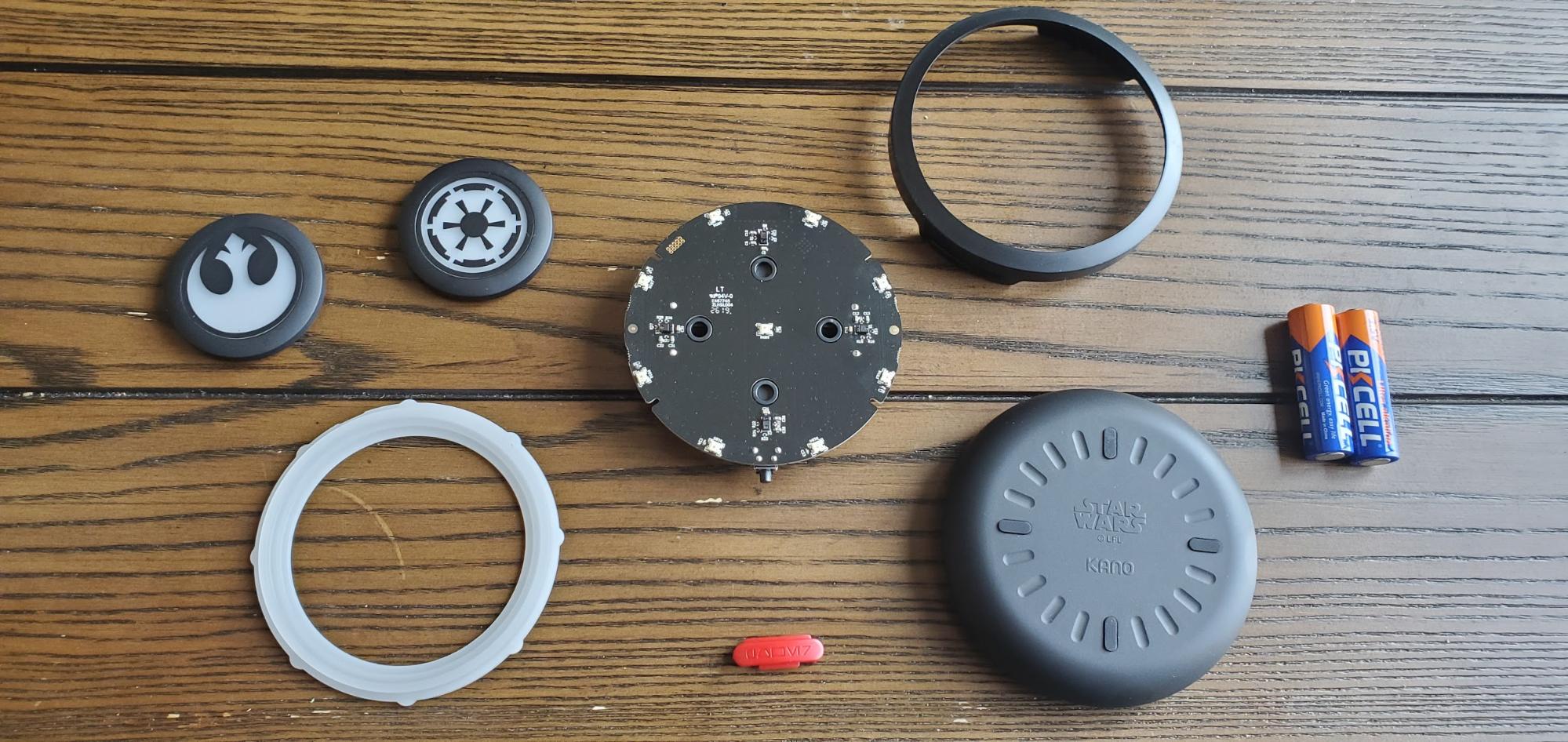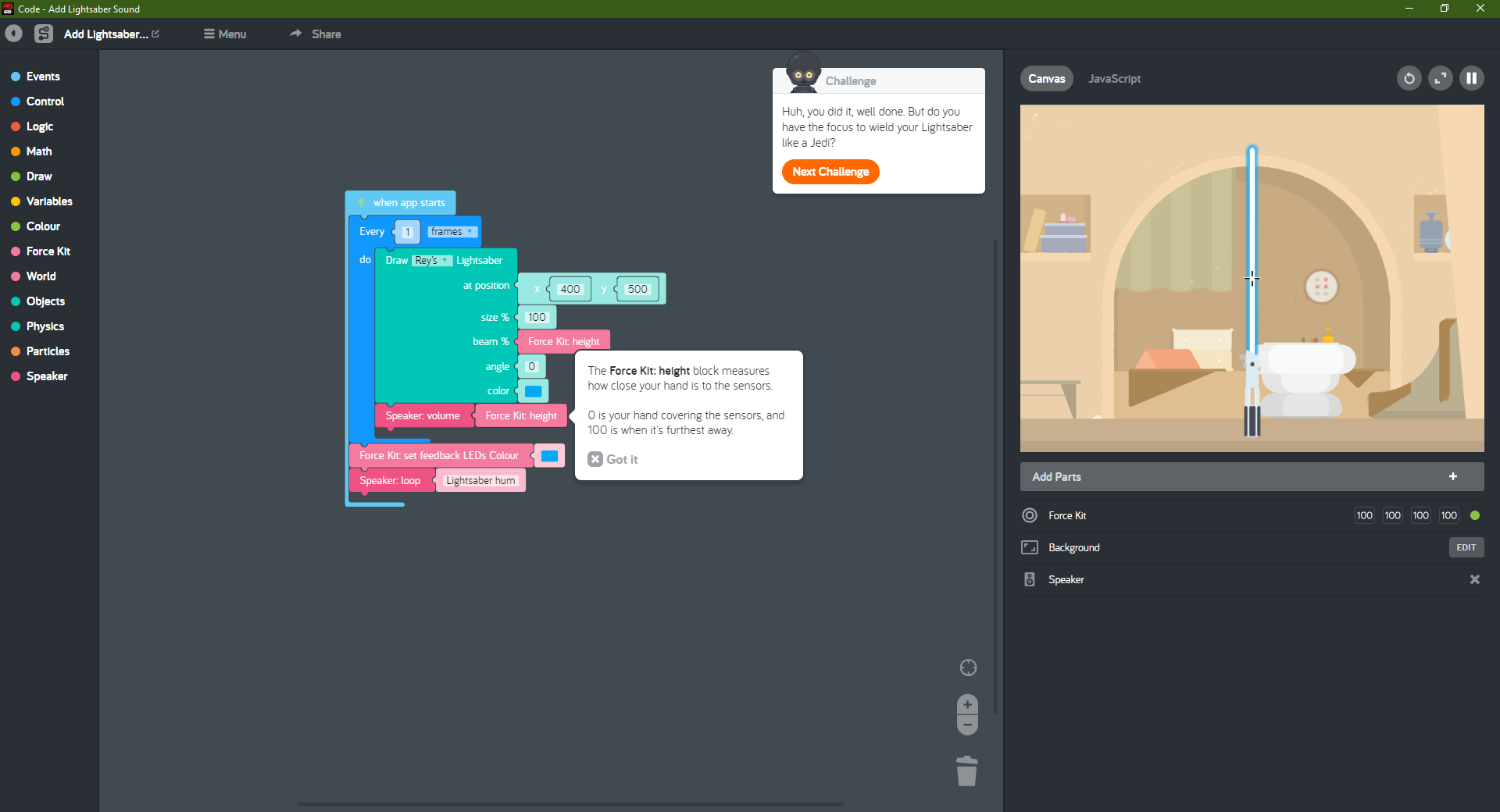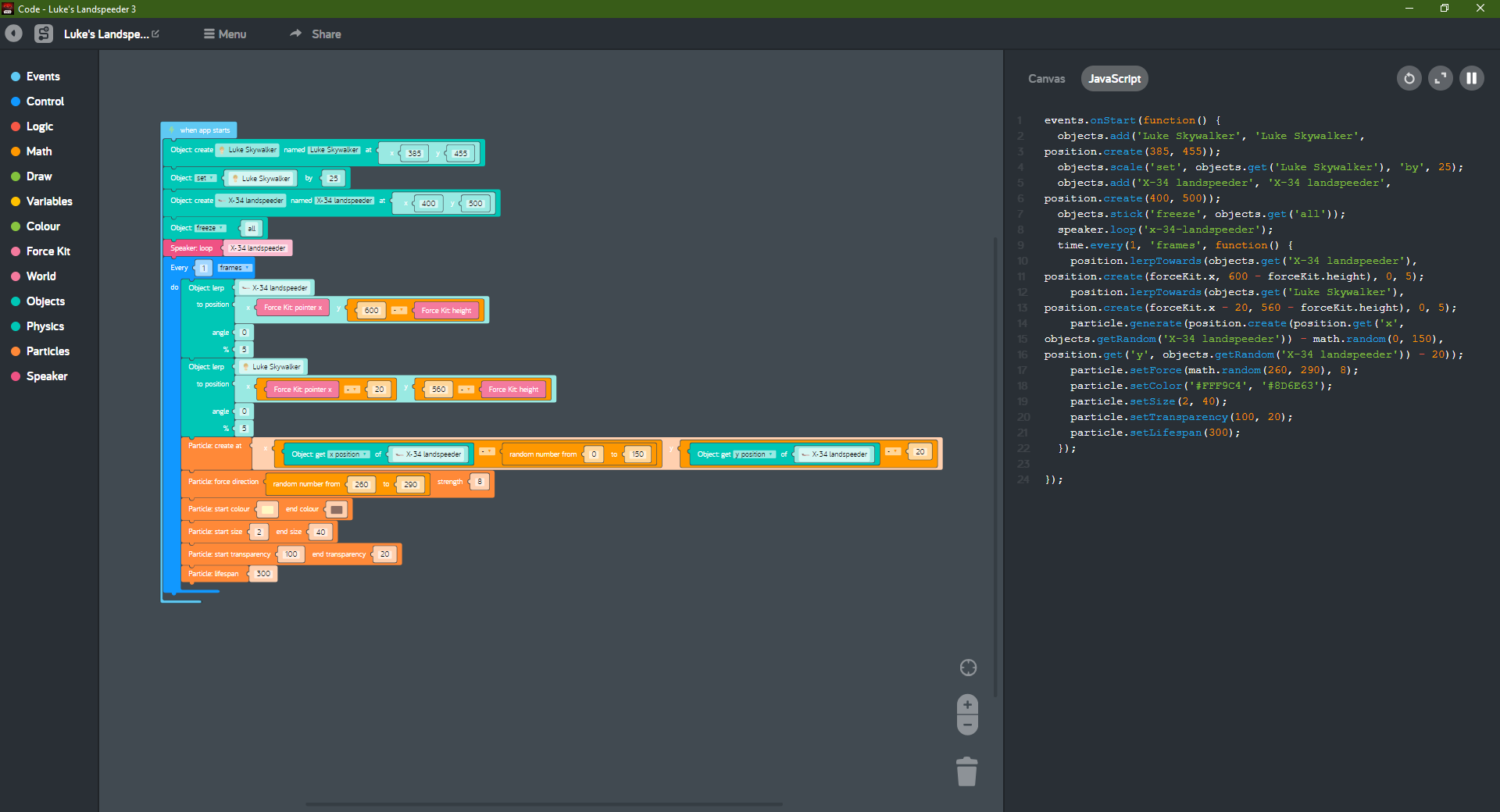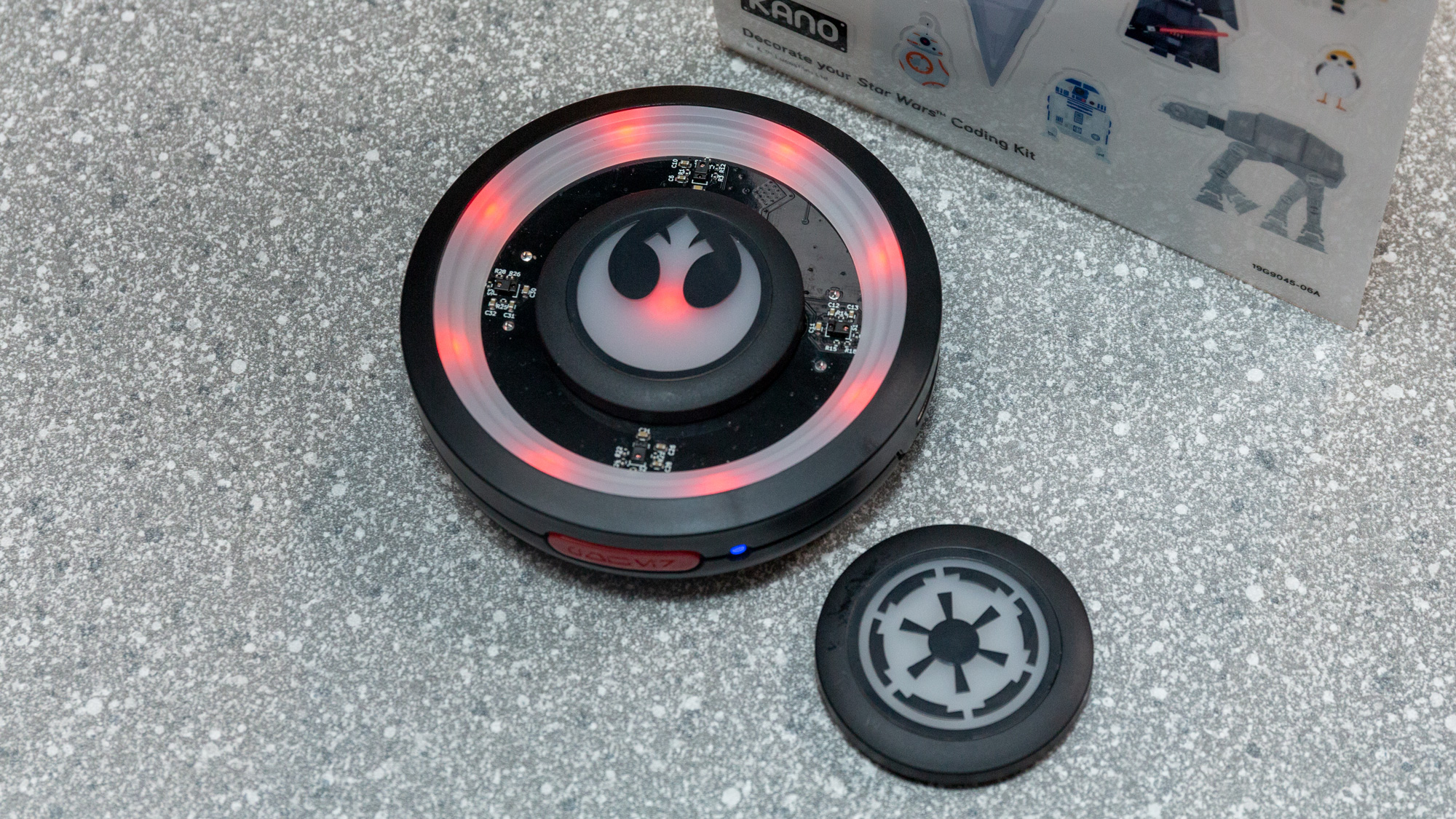Tom's Hardware Verdict
Kano: Star Wars The Force Coding Kit will entertain kids with the app’s playful tutorials. But lacking lessons and the inability to code in JavaScript means it’s not as educational as it could be. Plus, coding is mostly about app animations, making the physical toy a near afterthought.
Pros
- +
Fun and easy to build
- +
Nails the Star Wars theme
- +
Delightful block coding tutorials using kit’s motion sensors and RGB lights
- +
Good price
Cons
- -
Tutorials could be more informative
- -
No JavaScript coding
- -
RGB lights are dull and sometimes inaccurate
- -
You’re mostly coding an animation in the app, not the physical toy
Why you can trust Tom's Hardware
The Kano: Star Wars The Force Coding Kit ($79.99, ages 6 and older) comes with a motion sensor controller kids build themselves that gives them control over a JavaScript animation in the accompanying app for iPad, Windows/macOS PC or Amazon Fire. Block coding tutorials teach you to use the Force Kit’s sensors to do things like control Lightsaber movement or Stormtroopers seen in on-screen animations by moving your hands across the motion sensor.
By combining STEM, Star Wars (there’s also a Frozen 2 version available), colorful, playful tutorials and a small number of RGB lights, Kano has enough to get kids interested in block coding. But unlike the best STEM toys, without a lot of instructions on how to make the most with the app-specific block code or the ability to graduate to JavaScript (or any real-life programming language), your child may move on from this toy before you’d like.
Kano: Star Wars The Force Coding Kit Specs
| Sensors | 4x motion |
| Lighting | 9x RGB LEDs |
| Connectivity | Bluetooth 4.2 |
| Batteries | 2x AA (included) |
| Compatibility: | Windows: 10, S mode (1703 Creator’s Update or newer) |
| Row 5 - Cell 0 | iPad: iOS 12 or iPadOS |
| Row 6 - Cell 0 | Mac: macOS 10.13 or later |
| Row 7 - Cell 0 | Amazon Fire: Fire OS 5.6.2.0. or higher |
| Dimensions (HxWxL) | 1.1 x 3.8 x 3.8 inches (27.9 x 96.5 x 96.5mm) |
| Weight | 0.3 pounds (0.1kg) |
| Warranty | 1 year |
| Price | $79.99 / £79.99 |
Design and Building
When you open up the box, you’re met with some parts for building what Kano calls the Force Kit. But don’t worry about getting your kid a toolkit; this is more like snapping things together. But considering this is for kids as young as six years old, it’s appropriate. Meanwhile, slightly older kids can take greater heed of the instructions provided in the print-out manual. They teach the child that the printed-circuit board (PCB) is comprised of sensors, microprocessors, LED lights, resistors (see resistor color codes) and tracers. But besides the sensors, neither the manual nor the app tells you what any of those things are or how they work.
What you do learn about are the PCB’s four motion sensors. The included manual explains that each sensor has two “lenses” atop one another, with the top one sending out an infrared beam “a type of light invisible to humans.” When a hand interrupts the beam, the beam’s reflected down to the bottom lens, and this is how the controller knows where your hand is moving. With this motion detection, the controller is used to influence animations coded in the kit’s accompanying app.
For example, you can program a Lightsaber in the app to move left and right as your hand slides that way across the controller. Or you can make virtual Stormtroopers go flying backwards when you make a pushing motion with your hand across the Force Kit. Since the motion sensors are the core of the Force Kit, the manual’s details do provide kits with a big picture idea of how things work.
Occasionally I found the sensors finicky. Perhaps it’s because my hands are larger than that of the intended user. But sometimes the sensors couldn’t keep up with me, such as when I tried swiping a lightsaber left and right. However, moving my hand slower seemed to help.
After you learn about the PCB and add the included AA batteries into its back compartment, you snap it into the plastic black bottom case. The red power button, with Aurebesh language inscriptions, is supposed to fit “snug” on a knob sticking out of the PCB’s side, but mine was wobbly (you always have the power button face you, so the app knows which direction you’re facing). Similarly, a plastic “light ring” is supposed to fit into place on top of the PCB, but mine didn’t snap in securely until I added the plastic top case ring.
Get Tom's Hardware's best news and in-depth reviews, straight to your inbox.
After you snap the plastic top case ring, you get to pick an icon representing your side, either Empire or Rebel, that snaps into the PCB with four pegs. When it’s finally completed, the motion controller Iooks simple, yet interesting. I appreciate the sci-fi vibe the exposed PCB brings, but with this in children’s hands, it does make it slightly more susceptible to damage.
There are eight LED lights on the PCB that shine evenly throughout the frosted white light ring, which acts as a light diffuser, plus one more LED in the center that illuminates the Empire or Rebel badge selected. But unless the lights are set to the color white, where there white-colored light ring and badge enhance a prismatic effect, they look like nine individual spots of light dulled by a white overcast.
The LED lights on my unit also had trouble producing some colors. Setting the lights to the browns available in the app’s 209-color palette resulted in the lights either looking red or off. The lights also looked off when I tried setting the lights to black or gray.
Ultimately, the Force Kit is very quick to build and, therefore, take apart and rebuild. And your child should even learn a thing or two along the way.
I appreciated the toy’s printed-out manual. Cuter versions of Star Wars characters sprinkle the pages, and it conveys directions in a digestible manner, with one page per direction featuring one large picture and short sentences.
The manual also advises you to visit help.kano.me for support and provides troubleshooting codes to enter for the motion sensor controller not powering up, issues connecting the toy via Bluetooth and more.
The Force Kit connects to your PC or tablet using Bluetooth. A blue light on the side of the kit flashes when searching for a connection and is solid when successfully connected, which helps with potential connection hiccups.
Speaking of Bluetoooth, this is another missed opportunity for STEM learnings. Besides being a motion-detector light, the kit is useless without Bluetooth connection to a supporting iPad / Amazon Fire tablet or Windows / macOS PC. Bluetooth is at the core of this toy -- and many everyday electronics kids are likely to encounter -- but this toy doesn’t teach you what Bluetooth is or how it works with this kit.
Coding
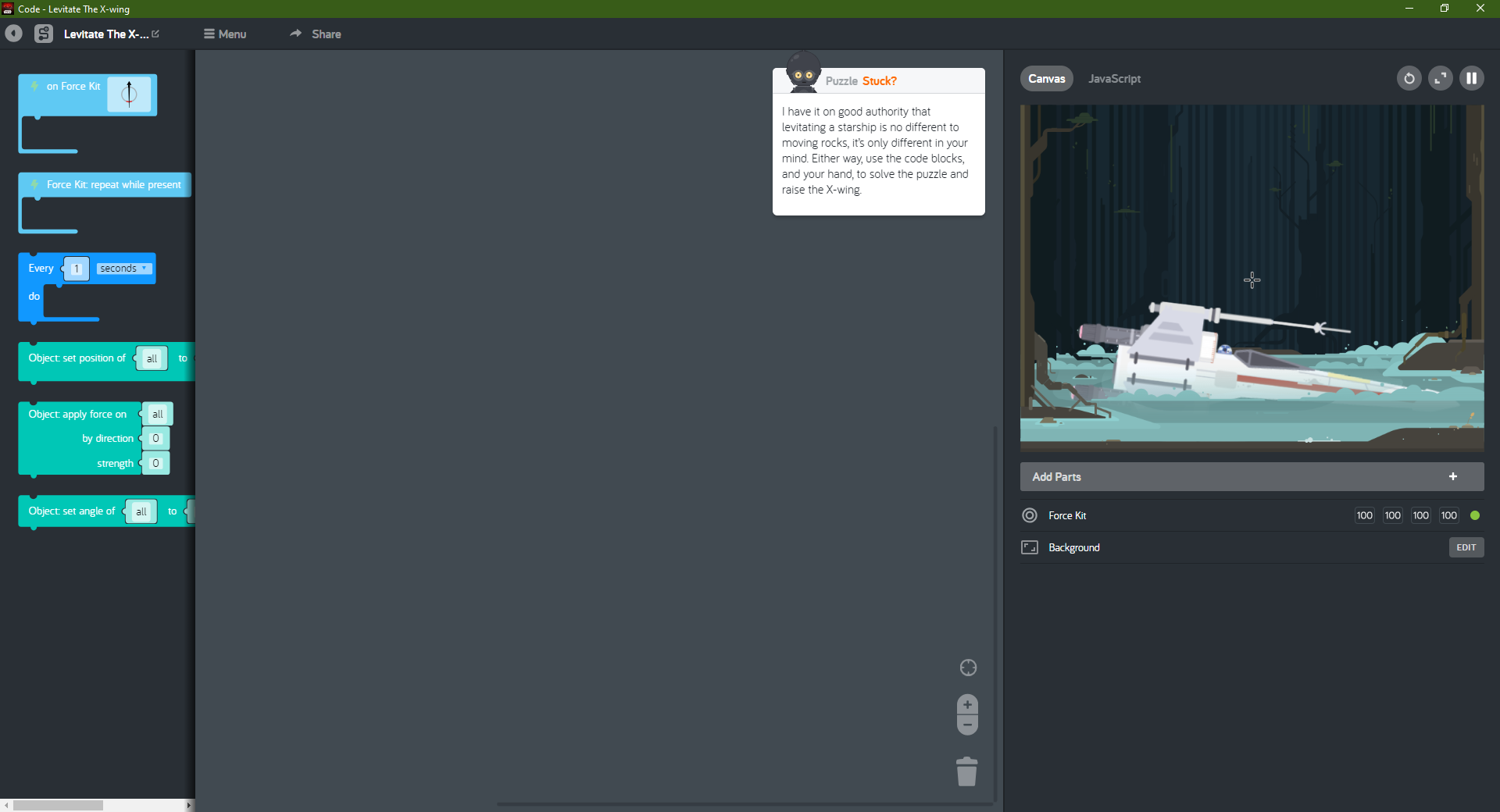

The free “Star Wars The Force Coding Kit, by Kano” software (yes, that whole name will appear on your desktop) takes up 194.7MB of storage space. It’s a simple app with Star Wars-themed tutorials that instruct kids to use the app-specific block coding to change various JavaScript animations on the right panel. Perhaps there’s a Lightsaber there that you’re prompted to code to move with your hand as it swipes left and right across the Force Kit. Or maybe you’re tasked with helping a TIE fighter fly through a field of asteroids.
At the time of review, there were three tutorials with 17 lessons total. Kano says that there will be another tutorial with four lessons before the end of November. One of the upcoming tutorials, which sounds like the coolest yet, is called “Influence the Weak Minded.” A spokesperson said the tutorial will focus on “coding Jedi mind tricks,” and “users will learn to control things like Stormtroopers and AT-ATs.”
One of my favorite parts of the software is its use of sensor data. When coding, the right panel, (which also lets you change the background of the canvas to your preferred Star Wars environment), the app always shows how far your hand is from each of the four sensors on a scale of 0 to 100. The image below is an introduction to this feature:
The problem with the app, though, is the majority of these lessons merely direct kids to drag in a particular block or change a value but with little or, sometimes, no explanation for why. Additionally, the canvas you’re coding relies on frames, like all animations; however, this isn’t something that a young child is likely to understand already. Some of the block codes measures things by frames, yet, the app never teaches children how videos are comprised of still frames, a fundamental part of the app.
Some of the first tutorials have a Lightsaber in the canvas change height based on how far your hand is from the sensors on the real-life Force kit and adds the famous Lightsaber hum noise. It’s easy enough to follow the directions to make it work, but there’s minimal explanation of the logic behind your selection.
For example, when it came to the lerp block, the lesson says, “The lerp block will help make the motion of the Lightsaber smoother. Change 0 to -20 so Rey’s lightsaber tilts left when it moves left.” What the lerp?! It continues, “Change 200 to 20 so it tilts right when it moves right.” Come again? Next: “Drag this block into the code space.” Whatever you say K-4NO...no questions asked.
Even basic things, like changing the direction of particle effects representing stars to 360 degrees because that’s a full circle, seem easy and appropriate to teach briefly in a STEM toy. But you won’t find that here.
Below is a screenshot (see how to take screenshots in Windows) from one of the later tutorials. It starts you off with so much code but zero details on what it all does.
Helpfully, when I slid a block into the wrong spot, my instructor, K-4NO, prompted me to put it elsewhere. But you’re not always corrected when making errors during tutorials. For instance, when I entered the wrong number for the blast position of a TIE fighter, it didn’t notice. And you can’t undo; I had to start the lesson over from the beginning to make things work properly.
One thing the app gets right (thank the stars) is the Star Wars theme. If your child wanted a new Star Wars toy, they won’t be left wanting. The app incorporates different characters, costumes and items from the franchise. For example, when building a Lightsaber, you get to style your hilt in the style of Obi-Wan, Luke, Darth Vader, Yoda, Kylo Ren or Rey.
You’re also able to easily toggle the canvas to show the JavaScript version of your block code, but you can’t write code in JavaScript.
Codes automatically save in the “My Creations” section of the app.
Other App Features
The app’s Explore section lets you view codes others users have shared. Unfortunately, there’s no way to search through the different code based on category or keywords. You just scroll through pages of code that aren’t even chronologically ordered.
Children can also share their own programs. When first launching the app, kids are asked to enter a parent/guardian email address. Said adult has to confirm via email that their child can share programs with the Kano World community. According to the email, “these are moderated to remove all personal information.”
Kids can also have or get followers on the app and customize their own avatar, including with Star Wars companions, objects and accessories. There’s also an experience points system. But it seems to work like “Whose Line Is It Anyway” where points don’t seem to mean anything in the game or otherwise (besides bragging rights).
After you’ve become a Jedi--err, Force Coding Kit master-- kids can code freely in the Create section of the app. You have to use the blocks; there’s no way to enter JavaScript code directly.
You can also import/export code as a “KCODE File,” which doesn’t seem like it’ll really ever come in handy.
Battery Life
Each Star Wars The Force Coding Kit comes with two non-rechargeable AA batteries. Kano claims the Star Wars coding kit will last for “over 10 hours of constant play.” During testing, mine was still alive after 9 hours and 10 minutes on with Bluetooth and intermittent usage of sensors, plus RGB lights set to on for the majority of the time. Of course, battery life will depend on your choice of AA batteries after the included ones die.
Compatibility and Configurations
If your kid’s not into Star Wars, Kano also sells a version of this kit based on the Disney movie Frozen 2. The Kano Disney Frozen 2 Coding Kit is also $79.99, but the toy looks looks like a giant blue snowflake, which is eye-catching but lacks the exposed PCB look I like.
Both kits are compatible with Windows PC, Apple iPad and macOS and Amazon Fire HD 10 (2017 or newer). Each platform has hardware requirements; you can find the tech requirements here.
Bottom Line
Kano: Star Wars The Force Coding Kit offers fun block coding that’s certainly simple enough for the recommended ages 6 and up. Building the kit goes from fun to fascinating with the motion sensor RGB lights. The app’s Star Wars theme is lively and captivating with its soft color palette and cute, on-brand tutorials.
However, the toy could be more educational. Coding tutorials don’t provide much explanations, mostly prompting kids to drag in specific blocks. Unlike competitors, such as the Sphero Bolt, it misses an opportunity to teach about other STEM-related topics like Bluetooth, angles or physics. And while kids can toggle block code into JavaScript, they can never actually write code in JavaScript.
The similarly priced Sphero Mini brings more to the table, including a gyroscope, accelerometer, cones, mazes and activity cards for creating projects and games. Plus, Sphero’s tutorials are more in-depth, but geared more for classroom settings. Kano is adding lessons, but we’re not sure for how long your kids will want to use this toy for free coding, especially with limited instructions.
But many other STEM toys will cost you much more than the Star Wars The Force Coding Kit.
It's a delightful approach to getting your kid at least somewhat interested in block coding and immediately intrigued by motion sensors. Who can resist controlling lights with their hand?

Scharon Harding has over a decade of experience reporting on technology with a special affinity for gaming peripherals (especially monitors), laptops, and virtual reality. Previously, she covered business technology, including hardware, software, cyber security, cloud, and other IT happenings, at Channelnomics, with bylines at CRN UK.
